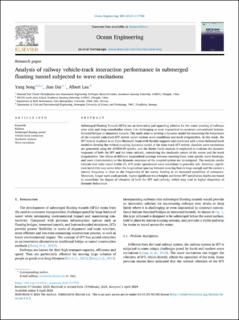| dc.contributor.author | Song, Yang | |
| dc.contributor.author | Dai, Jian | |
| dc.contributor.author | Lau Leong Lee, Albert | |
| dc.date.accessioned | 2024-04-23T11:27:37Z | |
| dc.date.available | 2024-04-23T11:27:37Z | |
| dc.date.created | 2024-04-21T13:23:56Z | |
| dc.date.issued | 2024 | |
| dc.identifier.issn | 0029-8018 | |
| dc.identifier.uri | https://hdl.handle.net/11250/3127776 | |
| dc.description.abstract | Submerged Floating Tunnels (SFTs) are an innovative and appealing solution for the water crossing of railways over wide and deep waterbodies where it is challenging or even impractical to construct conventional bottom-founded bridges or immersed tunnels. This study aims to develop a dynamic model for examining the behaviours of the coupled train-track-SFT system under various wave conditions and track irregularities. In this study, the SFT tube is idealised as an Euler-Bernoulli beam with flexible supports and combined with a train-ballasted track model to develop the vertical coupling dynamics model of the train-track-SFT system. Random wave excitations are generated using the JONSWAP spectra, and the Monte Carlo analysis is employed to evaluate the dynamic responses of both the SFT and the train carbody, considering the stochastic nature of the waves and the track irregularities. The effects of different longitudinal spacings between mooring lines, train speeds, wave headings, and wave characteristics on the dynamic responses of the coupled system are investigated. The analysis results indicate that train travel within the SFT under operational wave conditions is generally safe. However, significant instability may occur when the longitudinal spacing between mooring lines is large enough and the system's natural frequency is close to the frequencies of the waves, leading to an increased possibility of resonance. Moreover, longer wave peak periods, higher significant wave heights and lower SFT installation depths are found to exacerbate the degree of vibration of both the SFT and carbody, which may lead to higher dispersion of dynamic behaviours. | en_US |
| dc.language.iso | eng | en_US |
| dc.publisher | Elsevier | en_US |
| dc.rights | Attribution-NonCommercial-NoDerivatives 4.0 Internasjonal | * |
| dc.rights.uri | http://creativecommons.org/licenses/by-nc-nd/4.0/deed.no | * |
| dc.title | Analysis of railway vehicle-track interaction performance in submerged floating tunnel subjected to wave excitations | en_US |
| dc.title.alternative | Analysis of railway vehicle-track interaction performance in submerged floating tunnel subjected to wave excitations | en_US |
| dc.type | Journal article | en_US |
| dc.type | Peer reviewed | en_US |
| dc.description.version | publishedVersion | en_US |
| dc.source.volume | 303 | en_US |
| dc.source.journal | Ocean Engineering | en_US |
| dc.identifier.doi | 10.1016/j.oceaneng.2024.117760 | |
| dc.identifier.cristin | 2263222 | |
| cristin.ispublished | true | |
| cristin.fulltext | original | |
| cristin.qualitycode | 1 | |

